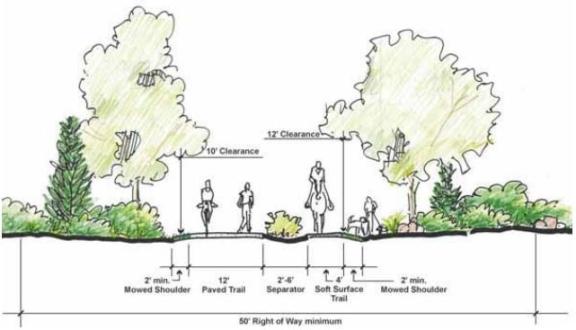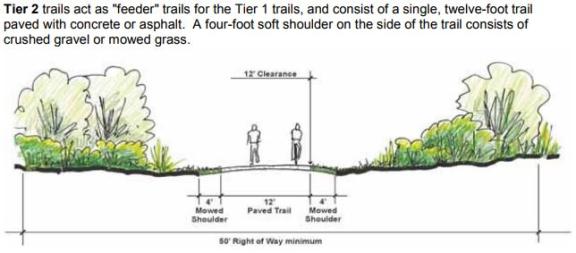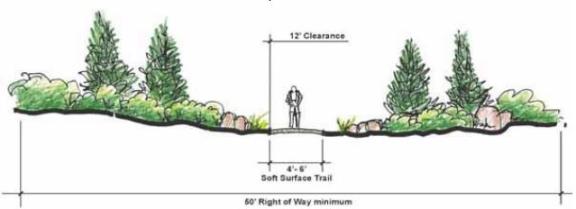Multi-Use Urban Trails
Urban trails within Colorado Springs are an important part of the community. Urban trails are not only used for recreational purposes but also provide residents an off-street transportation system for non-motorized uses.
Urban Trails are all designated as multi-use trails. This means that any non-motorized use of the trail is permitted. All of the trails are open to joggers, bicyclists, walkers, equestrians, roller blades, etc. The only exception to this rule is through Monument Valley Park, where deed restrictions prohibit equestrian use of the trail.
Please follow trail etiquette while utilizing any trail. The current Urban Trail System consists of over 100 miles of trails, with another 100+ miles of planned trails identified in the Urban Trails Master Plan.
Urban trails include:
- Cottonwood Creek Trail
- Homestead Trail
- Midland Trail
- Pikes Peak Greenway
- Rock Island Trail
- Sand Creek Trail
- Shooks Run Trail
- Sinton Trail
- Stetson Trail
- Templeton Gap Trail
- Woodmen Trail
- Foothills Trail
- Skyline Trail
- Rockrimmon Trail
- Mesa Valley Trail
Trail maps
- CO Trex Colorado Trail Explorer
- View bike maps (Includes urban trails)
Types of Urban Trails (Tiers)
The current trail standard is based on a "tier" system. Both Tier 1 and 2 trails are designed to accommodate a variety of Other Power Driven Mobility Devices (OPDMD) for people with disabilities who need to use a mobility aid.
Tier One trails: the main "spine" trails
Function: Multi-purpose trails accommodate a variety of trail users including walkers, joggers, recreational bikers, commute bikers, and horseback riders (as appropriate) within the same trail corridor. Serve the highest volume of users.
Design Guideline: 12-foot wide main trail with a separate but parallel gravel trail ( four feet wide), good line of sight, and layout designed for commuter speeds and a high volume of users. A soft surface gravel or mowed grass shoulder on each side of the trail should be provided to reduce user conflicts.

Tier Two trails: "feeder" trails that lead to tier 1 trails
Function: Feeder trails for the Tier 1 trails provide for a diversity of users including bicyclists, in-line skaters, walkers, runners, and equestrians.
Design Guideline: Single 12-foot trail paved with concrete or asphalt. A four foot soft shoulder on each side of the trail is provided to reduce user conflicts. The right-of-way easements should be 50 feet in width where feasible.

Tier Three trails: smaller, natural trails
Function: Less improved trails located in the mountains or foothills serving primarily hikers and mountain bikers. These trails, which are expected to receive less use than the Tier 1 and 2 trails.
Design Guideline: Four to six-foot wide, soft surface trails with no shoulders. Equestrians would share use of the four to six-foot wide trail.

Follow the Leave No Trace Seven Principles
The City of Colorado Springs Parks, Recreation & Cultural Services department is proudly partnered with the Leave No Trace Center for Outdoor Ethics in order to promote environmental stewardship and safeguard the natural, cultural, and historical resources that make Colorado Springs such a fantastic place to live and visit. Follow the Leave No Trace Seven Principles to help keep our parks, trails, and open spaces healthy and sustainable. Learn more at lnt.org
|
| Plan ahead and prepare. The urban trails throughout the city provide great opportunities to avoid the busy streets and reduce carbon emissions - but no restrooms are offered. Plan a loop, have plenty of water, and use the restroom before you go. |
|
| Travel on durable surfaces. A majority of the urban trails run along creeks; staying on urban trails helps prevent erosion of the creek banks and damage to our watersheds. Urban trails are an excellent option for when muddy conditions are present elsewhere! |
|
| Dispose of waste properly. There are extremely limited trashcans available along the trails so plan to pack out all articles of trash, including pet waste. This keeps harmful pollutants out of the watershed and helps it stay healthy. |
|
| Leave what you find. Removing rocks or vegetation from the sides of the trail can cause erosion issues. Instead of taking a neat looking rock or a pretty flower home with you, snap a picture and leave it lay to prevent bank erosion. |
|
| Be careful with fire. Flames and fences are not a friendly combination. Fires, charcoal grilling, and smoking are prohibited on the urban trails. Help us protect the trails and our neighbors from the dangers of fire. |
|
| Respect wildlife. Creeks along our urban trails are a vital water source for all sorts of wildlife that share our city. Give them their space and keep your pets on leash to avoid scaring wildlife away from one of their basic needs. |
|
| Be considerate of others. Be courteous of all trail users. Our urban trails see dog walkers, cyclists, roller skaters, runners, and many other types of trail users, give them a wave and share the trails. |
